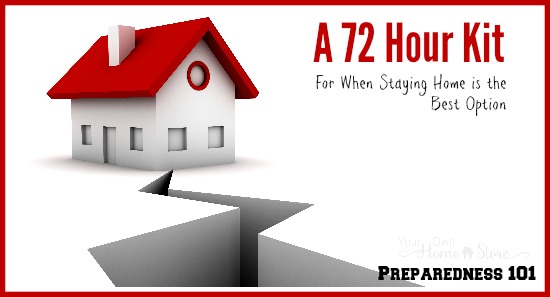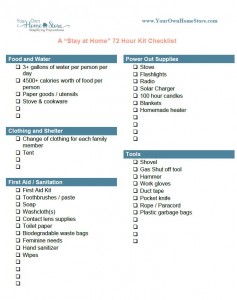Fema recommends that every person have 3 days worth of food, water and supplies in their own home. If disaster were to strike your area, it could take a few days (possibly even more than three) for help to get to you. And even when help does get to you, electricity, gas, water, sewage treatment and telephones could be down for much longer.
Some links in this post may be affiliate links, meaning at no additional cost to you, I may earn a small commission if you choose to purchase something. I only link to products I own, trust and would recommend to my family. Thank you for your support in this way!
Reasons
There are many reasons for having a 72 hour kit to use after a disaster. In fact, 72 hours is truly an absolute minimum.
Being prepared with a supply of food, water and supplies can help in a myriad of situations from job loss, to unexpected medical bills, to simply forgetting about dinner.
However, the reality is that natural disasters are part of emergency preparedness. Earthquakes, tornadoes, and hurricanes are (sadly) occurring more and more often. Even less “infamous” disasters such as floods, landslides, severe storms (especially in the winter), quarantines, and tsunamis are finding their way into the news more and more often.
Natural disasters affect entire cities, counties or even entire states at times. As such, they put a huge load on local resources. Following a natural disaster, water, food, shelter, and medical supplies and help are often difficult to find.
While those outside the immediate area often mobilize quite quickly to “come to the rescue,” they simple can’t reach everyone immediately. Travel is often difficult and the numbers of those needing assistance make this process even slower.
Being able to provide for yourself in these situations is important and most (not all) of the time, staying put is your best option. Typically, most of your supplies are at home. You usually have a built in support system of friends and family at home. And often, even a home that has been through a natural disaster can provide some sort of shelter.
However, there are some situations where leaving may be the better option, but we will discuss those in a few weeks. For today, we are simply worried about a kit that will allow you to take care of your family immediately following a disaster of some sort.
Don’t Fear…Be Proactive
And as I often mention, I don’t want this website to be fear based. I don’t want anyone to start panicking. Many of us will face a disaster of some sort in our lives. And many of us won’t. But being prepared for one will help in other situations! Having food and supplies in your home is simply smart! It makes day to day life easier and less stressful.
Got home late from a doctor’s appointment? No problem! Pull out a meal in a jar and dinner will be ready in minutes. Power out in your neighborhood because of a car accident? No problem. Pull out the power out supplies and make a fun night of it!
But when natural disasters do occur, the more people who are prepared to help themselves for 3 (or hopefully more) days, the better! Can you imagine how different things would be following a hurricane or earthquake if every single person had 3 or more days worth of water and food?
The overwhelming fear and stress and panic many experience following these situations would be far more manageable. I also believe that fighting and looting and stealing would decrease. The general public would be more willing to help, share and work together.
Having these supplies is not just a service to your own family, but to your entire community in a situation like this. Conversely, refusing to have these supplies is a drain and stress to your community.
A 72 Hour “Stay Home” Kit
So, let’s talk about what the kit Fema recommends should look like. This is not the same as a 72 hour kit that is meant for an evacuation, though some of the supplies may be similar. For the purpose of this post, I’m calling it a 72 hour “stay home” kit.
Thankfully, you have already gathered some of these supplies in previous weeks during this course! There are 5 main categories to think about:
- Food and Water
- Clothing and shelter
- First Aid and sanitation
- Power out supplies
- Tools
Before I get into the details of each category, let’s talk about how and where to store these supplies.
How To Store Supplies
Many of you (myself included) have (or soon will have) a larger than 72 hour supply of the above items. That is awesome. That is the eventual goal! But in a natural disaster, some of those extra supplies may be destroyed. Even if they aren’t, they may not all be accessible. Maybe your store them in different areas around your home or in a basement (me!) where they may be buried or difficult to reach immediately.
I suggest keeping this particular 72 hour kit all together in one box / tote. It’s purpose is to make those first few days following a disaster easier.
If your area is prone to tornadoes, keep it in a shelter. If your area is prone to hurricanes, keep it in a plastic bag / tote to keep it dry. If your area is prone to earthquakes (me!) do NOT keep it in the basement where it may get buried. Consider putting it under a work bench or table (in the garage?) where it will be (better) protected from falling debris. Another option would be keeping it in your car.
Obviously, no matter where you keep it, you can’t guarantee that it will be safe and easy to find following a disaster, but you can increase those chances!
Printable Checklist
I’ll list out the details of the supplies below, but you can print out this check list to help you keep track of it all. There are even places to add your own ideas (or those you find on other sites) to the list! Just click HERE to print (or on the image below):
Food and Water:
Your “at home” kit should have at least 3 gallons of water per person in it. 1/2 gallon / day will be used for drinking and the other 1/2 gallon for washing and cleaning etc. I use water bottles (and rotate them regularly) in this kit.
In addition, you should have at least 3 days worth of food in your kit. Make sure you don’t skimp on the calories. Those first three days following a disaster will likely be stressful and require a lot of energy from you. Make sure you have the calories to meet those demands. I suggest at least 1500 calories per person per day.
A few options:
- No cook food: This list of food is inexpensive, high in calories and requires no utensils, plates or cooking. I don’t know that I will want to be cooking immediately following an experience like that.
- Favorite comfort foods: In addition to the no-cook food, I do think that my family will enjoy some of our favorite “comfort” foods, so I also keep just add water jar meals in our kit. We love spaghetti and chicken noodle soup. A few other recipes that will work well as jar meals are chicken salad (doesn’t even need to be heated), tomato soup, chicken spaghetti. You could also stock just add water meals from a food storage company like the Thrive Express.
- Canned foods: Easy to heat soups (like Campbells) are readily available at the grocery store. Just make sure you rotate them b/c of the shorter shelf life.
Make sure you also include any necessary plates / bowls, utensils, can openers, pots and a small stove if needed. I use this butane stove (fuel is stable enough to be shipped. I buy it here) and this cookware.
Clothing and Shelter
Your clothes may be soiled or dirty or ripped following a natural disaster. I suggest keeping one change of clothing for each family member in your kit.
In addition, if your home is not safe to stay in, but you still want to stay in your neighborhood near friends / family, you should have a tent. The tents I keep in our 72 hour evacuation kit are small and lightweight, but I keep our family camping tent near this “stay home” kit. It is much more roomy and will protect us much better from the elements.
First Aid / Sanitation
Hopefully, all of you completed a first aid kit last week! Either keep your first aid kit with your “stay home” kit or split your supplies in two and put some in your “stay home” kit.
I suggest keeping basic sanitation and personal care supplies here as well. Add toothbrushes, soap, a washrag, contact lens supplies, a roll of toilet paper, biodegradable waste bags, feminine needs, hand sanitizer and wipes.
Power Out Supplies
I actually keep the bulk of our power out supplies in one closet upstairs. But I do keep a few basic supplies in this “stay home” kit.
I have the butane stove I mentioned earlier, matches, flashlights (and extra batteries), a windup radio, a small solar charger and panel (for phones, iPad, etc…I know I’ll want to distract my kids at times), and a few 100 hour candles. During the winter, I also add blankets and supplies for this homemade heater.
Tools
After a major natural disaster, you may need a few basic tools. I suggest at least a shovel, gas shut off tool, work gloves, duct tape, a hammer, a pocket knife, rope / paracord, and plastic garbage bags.
Hopefully, you will have other water, food and supplies stored in your home. I will help you do that through this course. However, today, let’s just start with 3 days worth of food and supplies. Don’t worry about the long term yet! Just start with this small step: 3 days. That’s it. 72 hours. Good luck!
PIN THIS FOR LATER!
Becky is a wildlife enthusiast and pet and livestock care expert with a diploma in canine nutrition. With over a decade of experience in animal welfare, Becky lends her expertise to Simple Family Preparedness through insightful info about pets, livestock, bee keeping, and the practicalities of homesteading.




